Carcinogenic formaldehyde in U.S. residential buildings: Mass inventories, human health impacts, and associated healthcare costs
ABSTRACT
Formaldehyde, a human carcinogen, is formulated into building materials in the U.S. and worldwide. We used literature information and mass balances to obtain order-of-magnitude estimates of formaldehyde inventories in U.S. residential buildings as well as associated exposures, excess morbidity, and healthcare costs, along with other economic ramifications. Use of formaldehyde in building materials dates to the 1940s and continues today unabated, despite its international classification in 2004 as a human carcinogen. Global production of formaldehyde was about 32 million metric tons (MMT) in 2006. In the U.S., 5.7 ± 0.05 to 7.4 ± 0.125 MMT of formaldehyde were produced annually from 2006 to 2022, with 65 ± 5% of this mass (3.7 ± 0.03 to 4.8 ± 0.08 MMT) entering building materials. For a typical U.S. residential building constructed in 2022, we determined an average total mass of formaldehyde containing chemicals of 48.2 ± 10.1 kg, equivalent to 207 ± 40 g of neat formaldehyde per housing unit. When extrapolated to the entire U.S. housing stock, this equates to 29,800 ± 5760 metric tons of neat formaldehyde. If the health threshold in indoor air of 0.1 mg/m3 is never surpassed in a residential building, safe venting of embedded formaldehyde would take years. Using reported indoor air exceedances, up to 645 ± 33 excess cancer cases may occur U.S. nationwide annually, generating up to US$65M in cancer treatment costs alone, not counting ~16,000 ± 1000 disability-adjusted life-years. Other documents showed health effects of formaldehyde exist, but could not be quantified reliably, including sick building syndrome outcomes such as headache, asthma, and various respiratory illnesses. Opportunities to improve indoor air exposure assessments are discussed with special emphasis on monitoring of building wastewater. Safer alternatives to formaldehyde in building products exist and are recommended for future use.




